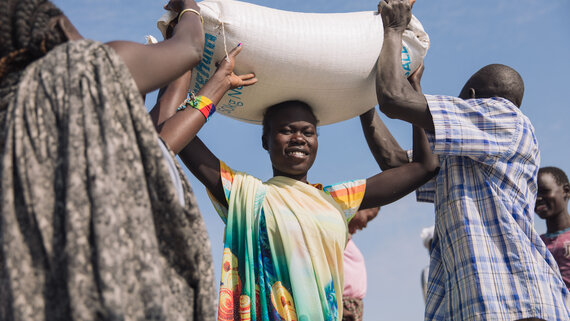FSL Sectoral People in Needs
FSL Sectoral Severity of Needs
Needs
As per the IPC analysis of October 2023, approximately 7.1 million people of the total population of 12.4 million will face acute food insecurity at crisis levels or worse during the peak of the lean season from April to July 2024, necessitating humanitarian food assistance. The most severely affected regions will include Jonglei, Unity, parts of Upper Nile, northern Warrap, Eastern Equatoria, Lakes, and Northern Bahr el Ghazal States. Additionally, certain areas, particularly Pibor in the Greater Pibor Administrative Area and Aweil East in Northern Bahr el Ghazal State, are expected to experience catastrophic food insecurity at IPC Phase 5.
For more information about the IPC and key drivers of food insecurity, please click here here
FSL Sectoral People Targeted
Response
Emergency Food Assistance (CO1):
Prioritizing counties historically affected by food insecurity due to conflict, climate shocks, and inequity, this component targets around 3.5 million individuals. It primarily involves distributing food rations and creating livelihood activities, strongly emphasizing areas facing emergency and catastrophic acute food insecurity. This approach seeks to reduce malnutrition, morbidity, and mortality rates, particularly among vulnerable groups such as children and pregnant or lactating women.
Context-Specific Emergency Livelihood Support (CO2):
This component aims to provide livelihood support to approximately 650,000 households (focusing on displaced populations) across 78 counties and Abyei, based on community consultations and state profiles available on the FSL cluster website. CO2 initiatives in hard-to-reach areas complement CO1 efforts and help vulnerable populations transition towards self sufficiency. Given the challenges in local markets, the response remains flexible, allowing for increased cash-based interventions when feasible and supporting local markets and community empowerment.
The response's impact is maximized through close coordination among FSL partners operating within the same locations and for the same beneficiaries. Partners involved in food assistance share beneficiary lists with those focusing on livelihood and resilience support to guide beneficiaries toward self-sufficiency. Additionally, plans for a joint intervention pilot in 2024, facilitated by WFP and FAO, focus on data sharing and geographic prioritization. Integration with other cluster interventions, including Health, Nutrition, WASH, and protection, remains a top priority.
Resilience support (CO3):
Aims to strengthen the self-reliance of 1 million people by reducing their dependency on FSL assistance through improved livelihoods, fostering market development, and implementing anticipatory actions. Capacity-building and the creation of community infrastructure aim to promote sustainability, aligning with long-term development and peacebuilding goals in collaboration with relevant stakeholders.
"Our disability does not deter us from food production and hence we need land for farming."
- A 60 years old man in Jonglei state

Malakal PoC site, Upper Nile State, South Sudan
An IDP woman carries a sack of sorghum she received during general food distribution.
OCHA/Sarah WaiswaMonitoring
Most output level indicators will be monitored through monthly 5Ws collected by partners. Cross-cutting indicators around GBV, child protection, and AAP will be monitored quarterly to track the progress of the humanitarian response. Quality standards, checklists, best practices, and other cross-cutting guidelines are shared with partners, along with periodic presentations on AAP, GBV, PSEA, and general protection to build greater AAP. Complaint and feedback mechanisms are used to better engage with affected populations. Regular field visits and lessons learned exercises verify data accuracy and ensure that recommendations are fully considered in the response.

